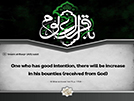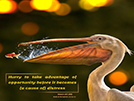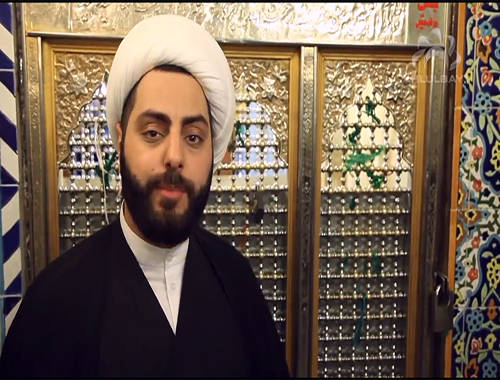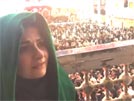Chapter 9-The Struggle for Legitimacy
- Details
- Hits: 13751
Chapter 9
The Struggle for Legitimacy
What has so far been said completes the first and fundamental
phase in the history of the development of Shi`i Islam. In this
phase a rather specific direction, a well-defined trend of
thought, an ideal of polity, and an underlying principle of
religious adherence were established which can easily be
distinguished as the Shi`i interpretation of Islam. Perhaps
even at this early stage one can discern the basic difference
between the Shi`a and the rest of the community, for while
the former preferred to accept the leadership of only those
who derived their authority directly from the person of the
Prophet and in this way enjoyed divine sanction, the latter
vested the authority for the leadership in the community as
a whole, which was thus entitled to choose the leader.
With the death of Husayn, however, Shi`ism entered the
second phase of its history. While the basic principle remained
the same, disagreements arose over the specific criteria for
deciding who the divinely inspired leader was, and this led to
the internal division of Shi`i Islam. A study of the history of
religions would show that a common phenomenon of world
religions and their factions has been that they always split
over certain details when they enter the second phase of their
development. Islam too, and within it both the major groups
of Shi`is and Sunnis, could not escape this fate.
We have seen in the previous chapter that shortly before
the Tawwabun marched against the Syrians, Mukhtar arrived
in Kufa and tried to gain the support of Sulayman b. Surad
and his followers for his own plan to rise against the
Umayyads. The Tawwabun, however, refused to join him.
The personality and character of Mukhtar have been
subjected to a great controversy in early Shi`i history. Some
sources present him as an ambitious adventurer seeking
political authority for himself in the name of the Ahl al-Bayt.
Others give him the benefit of the doubt and accept that his
actions were in reality motivated by his love for the family of
the Prophet, though his approach and tactics were different
from those of the Tawwabun.
An exhaustive scrutiny of the sources may well prove that
he was a devoted follower of the House of `Ali and a sincere
supporter of their cause, but whatever the case may be, the
fact remains that he has generally been treated rather
unsympathetically by the sources of different schools for
different reasons. The Twelver Shi'i sources present him in
an unfavourable light since it was he who for the first time
began propaganda for the Imamate of Muhammad b. al-
Hanafiya, thus deviating from the line of Fatima. The non-
Shi`i sources, on the other hand, seem to have been influenced
by the anti-Mukhtar propaganda launched by both the
sympathizers of Ibn az-Zubayr and those of the Umayyads.
No serious study has so far been done on Mukhtar, and the
sketchy accounts given by some of the modern scholars 1 are
generally influenced, without a critical assessment, by the
sources usually hostile to him. Recently, however, Hodgson
has hinted that the blackening of Mukhtar's reputation and
the attempt to discredit him began from the time of his death. 2
The fact, however, remains that Mukhtar, in all probability
due to the quiescent policy of Zayn al-~Abidin,-to be discussed
below, was responsible for shifting the Imamate from the
descendants of the Prophet through Fatima to another son of
`Ali! Muhammad b. al-Hanafiya, thus creating the first
deviation from the legitimist body of the Shi`a. The word
legitimist may not be a good expression, but it is perhaps the
nearest English approximation to the idea of a central body of
the Shi`a, where the Imamate remained strictly restricted in
the line of `Ali and Fatima, coming from Hasan to Husayn
and then through explicit nomination from father to son,
usually to the eldest surviving son, until it ended with the
twelfth Imam. Our intention in the following chapters is,
therefore, to restrict our attention to the survey of this
legitimist or central body of the Shi`a, which was reduced to an
almost insignificant number after the death of Husayn by the
newly emerging revolutionary or Messianic branches of the
Shi`a. The use of the term legitimist and central body may
seem at this stage arbitrary and a premature description of a
later development; nevertheless, the fact remains that it was
this legitimist faction which ultimately re-emerged as the
largest and thus the central body of the Shi`a, and was
eventually to be known as the Imamiya or Ithna-`ashariya
(Twelver) Shi`a. The movement of Mukhtar and the idea of
the Mahdi attached to the person of Muhammad b. al-
Hanafiya, with its extremist and esoteric doctrines, or other
ramifications of the Shi`a, are therefore beyond the scope of
this study.
It may, however, be pointed out here for future reference
that from this time of the confusion in the leadership which
followed the death of Husayn, this study has to address itself
to two different questions: first, how legitimist Shi`ism
maintained its separate identity without being absorbed into
the emerging Sunni synthesis; and second, how it maintained
its own character distinct from the revolutionary and
extremist branches within Shi`ism itself. To resist the latter
form of absorption was indeed more difficult, since extremist
and revolutionary ideas are often more appealing than
moderate ones.
As long as Husayn was alive the Shi`is remained united,
considering him the only head and Imam of the House of the
Prophet. But his sudden death and the quiescent attitude of
his only surviving son 'Ali, more commonly known as Zayn
al-'Abidin, left the Shi'a in confusion and created a vacuum
in the active leadership of the followers of the Ahl al-Bayt.
Thus the period following Husayn's death marks the first
conflict over the leadership of the followers of 'Ali, resulting
in the division of the Shi'a into various groups.
'Ali Zayn al-'Abidin was the only one of the sons of Husayn
whose life was spared during the massacre at Karbala, since
he did not take part in the fighting due to illness. He was at
that time twenty-three years old. 3 After his return from
Karbala, Zayn al-'Abidin lived in Medina for most of his life,
avoiding any political involvement as much as he could. The
tragedy of Karbala left a deep mark on him and it was only
too natural that he bore a deep grudge against the Umayyads,
holding them responsible for the massacre of his father and
all other family members. In spite of this feeling, however, he
refrained from expressing any hostile attitude towards them.
As a result, the Umayyads also tried to maintain good
relations with him; in particular, Marwan b. al-Hakam and
his son `Abd al-Malik even showed a certain respect and
affection for him. 4
When the Medinese rose against Yazid b. Mu`awiya in the
year 62/681, Zayn al-`Abidin, in order to emphasize his
neutrality in the political struggle in the community, left
Medina and went to stay on his estate outside the city. 5 When
Marwan, the governor of Medina, was compelled by the
Medinese to leave the city, he took his wife to Zayn al-`Abidin
and asked him to protect her. Zayn al-`Abidin demonstrated
his magnanimity by accepting this responsibility; he sent her
to Ta'if escorted by his son `Abd Allah. 6 When Yazid's army,
led by Muslim b. `Uqba however, defeated the Medinese in
the battle of Harra, and sacked and looted the city, Zayn al-
`Abidin and his family were left unmolested. Moreover, while
all the Medinese were obliged to take a humiliating oath of
allegiance, declaring themselves slaves of the Caliph Yazid,
Zayn al-`Abidin was exempted. 7 If this information, so widely
reported by the sources, on the one hand illustrates the
neutral policy of Zayn al-`Abidin, on the other hand it also
indicated that the Umayyads, after killing Husayn, began to
realize the respect and regard which the progeny of the
Prophet commanded among the majority of the Muslims.
In the conflict between the Umayyads and `Abd Allah b.
az-Zubayr, Zayn al-`Abidin remained neutral. Ibn az-Zubayr
did him no harm, but held him in Mecca under his
supervision. Still another important factor in Zayn al-
`Abidin's policy was his reserved attitude towards Mukhtar,
who tried his best to gain his explicit support. Besides many
approaches to Zayn al-`Abidin, which Mukhtar made while
he was in the Hijaz, he even wrote a letter to Zayn al-`Abidin
from Kufa, offering his allegiance. 8 In avenging the blood of
Husayn, Mukhtar beheaded most of those responsible for the
tragedy. The head of `Ubayd Allah b. Ziyad, the chief
architect of the massacre at Karbala, was sent by Mukhtar to
Zayn al-`Abidin, not to Ibn al-Hanafiya, and was delivered in
a most dramatic manner. 9 The son of Husayn is reported to
have been seen so happy at that occasion that people said that
they had never noticed him so elated since that tragedy at
Karbala. Nevertheless, he continued his reserved and with-
drawn attitude towards Mukhtar. The sources even report
Zayn al-`Abidin as publicly denouncing Mukhtar in violent
terms which seem to warrant serious examination. 10 If these
reports are correct, however, the reason for Zayn al-~Abidin's
resentful attitude towards Mukhtar seems to have been the
latter's proclamation of Ibn al-Hanafiya's imamate, which
Zayn al-`Abidin considered as the usurpation of his own
rights.
Shi`i sources record a number of traditions stating that
Husayn expressly appointed Zayn al-`Abidin as his successor.
The most commonly reported tradition in this connection is.
that Husayn, before leaving for Iraq, entrusted Umm Salima,
the widow of the Prophet, with his will and letters, enjoining
her to hand them over td the eldest of his male offspring in
case he himself did not return. Zayn al-`Abidin was the only
son who came back and so he was given his father's will and
became his nominee. 11 Another tradition states that Husayn
nominated Zayn al-`Abidin as his successor and the next
Imam of the House of the Prophet just before he went out to
meet the Umayyad forces for the last encounter at Karbala. 12
There is no criterion for an historian either to accept or to
reject this sort of tradition. Perhaps the only guiding principle
which may be used is the general tendency of the epoch and
the common practice of the people of that period. Judging
from this angle, we may recall our earlier comment in Chapter
7 that Husayn, by virtue of his family and his own position
therein as the grandson of the Prophet, thought that it was his
right to be the Imam of the community. It would therefore be
natural to think that he bequeathed his heritage to his son to
maintain his family's tradition of leadership coming down
from the Prophet. Nevertheless, the fact remains unchallenged
that after Husayn's death the majority of the Shi'is
followed Muhammad b. al-Hanafiya and not Zayn al-`Abidin,
though the Tawwabun, as we have seen, thought of the latter
as their prospective Imam. Even the remnants of the
Tawwabun who survived the battle of `Ayn al-Warda were
attracted by Mukhtar to the side of Ibn al-Hanafrya. 13 The
reason was obvious. The Shi`is in Kufa, especially the mawali
among them, wanted an active movement which could relieve
them from the oppressive rule of the Syrians. They found an
outlet only under the banner of Mukhtar, and saw a ray of
hope in the Messianic role propagated by him for Ibn al-
Hanafiya.
On his part, Ibn al-Hanafiya did not repudiate Mukhtar's
propaganda for his Imamate and Messianic role; he never-
theless maintained a carefully non-committal attitude and
never openly raised his claims to the heritage of Husayn. 14 It
is indeed difficult to say whether Ibn al-Hanafiya's policy of
not publicly laying claims to the leadership of the Shi`is was
because of the serious risk such a claim would have entailed
or because he was aware of the fact that he. was not the
descendant of the Prophet. We have repeatedly pointed out
throughout this work, from the event of Saqifa till the
movement of the Tawwabun, that the main emphasis of the
Shi'is regarding the leadership of the community has been
focused upon the direct relationship to the Prophet. With
reference to Hasan and Husayn, we always find far more
emphasis on the idea of succession to the Prophet by blood
than to `Ali by blood. If all these overwhelming reports have
any historic merit, then it seems very strange indeed that
immediately after Husayn's death the emphasis has so
suddenly changed from the lineage of the Prophet to that of
'Ali. It is, therefore, most probable that, besides political
danger, Ibn al-Hanafiya, not being the descendant of the
Prophet, was hesitant to claim the Imamate for himself. This
also explains why Mukhtar was first so anxious to gain the
support of Zayn al-'Abidin; and when he lost all hopes of
winning the son of Husayn, only then did he turn to Ibn al-
Hanafiya. As for the other part of the problem, that is, how
the Shi'is of Kufa so readily changed their attitude and
accepted as their Imam a son of 'Ali who was not the
descendant of the Prophet, whereas Zayn al-'Abidin was,
some explanation must be sought. Perhaps the only answer to
the riddle may be found in the fact that most of the original
and main body of the Shi'a, with a clear doctrinal stand
regarding the idea of the leadership, had been much reduced
in number, first in the Karbala massacre with Husayn, and
then in the battle of 'Ayn al-Warda under the command of
Sulayman b. Surad al-Khuza'i. They were not only the hard
core and well grounded in their Shi`i! ideals, but also provided
intellectual and religious leadership and guidance to the
masses of the Shi`a of Ku fa. After Karbala and `Ayn al-
Warda, what remained in Kufa in the name of the Shi`a were
mostly the wavering commoners of the Arabs and the mawali
who in that desperate situation could not make the delicate
doctrinal distinction between merely a son of `Ali and a son
of `Ali from Fatima. To them, `Ali was, after all, the cousin of
the Prophet and also a member of the priestly clan of Hashim.
That the sanctity of the Banu Hashim was confined to
Muhammad after the Prophethood had been bestowed on
him, to the exclusion of other members of the family of
Hashim, as understood by the original body of the Shi'a, was
lost among these commoners. They were thus easily carried
away by the talented eloquence of Mukhtar and his successful
propaganda for Ibn al-Hanafiya as the deliverer (Mahdi)
from the tyranny and injustice inflicted upon them by the
Umayyads. It was, therefore, not so much the rights and
personality of Ibn al-Hanafiya which made the masses of the
Shi`is of Kufa accept him as Mahdi-Imam as it was their
desperate yearning for a deliverer from Umayyad domination
and oppressive rule. A careful examination of Mukhtar's
propaganda for Ibn al-Hanafiya would show that the
overriding emphasis in introducing him was on his role as
Mahdi and not so much on his being the Imam. This may
prove to have been the main factor which attracted people to
him.
Once, however, the idea was implanted it found its way and
swept away most of the unstable Shi`i masses. Once it became
a popular movement with certain hopes pinned to it, even
some of the remnants of the original Shi'a were also carried
away. It is indeed difficult to resist what we may call a popular
appeal and, especially in the situation prevalent in Iraq at that
time, even some of the firm believers in the leadership of the
descendant of the Prophet could not remain unaffected. Thus
the Mahdism of Ibn al-Hanafiya soon became the order of
the day among the Shi`is of Kufa. And, in course of time, the
idea was popularly spread and accepted by the people and
developed its own doctrines and dogma, legends and beliefs.
It produced its own poets, such as Kuthayyir and Sayyid al-
Himyari and others. The majority of the Shi`a thus in that
particular period became the followers of the Mahdi-Imam
(and not of the Imam only) attached to the person of Ibn al-
Hanafiya, and eclipsed, though only for a short period of
time, the Imams from the line of Husayn.
Being the son of Husayn and the eldest surviving
descendant of the Prophet, Zayn al-`Abidin could not tolerate
this situation for long. Though he maintained his quiescent
policy of not getting involved in any politico-religious
movement, he nevertheless resisted the acceptance of
Muhammad b. al-Hanafiya as the Imam, and the latter's
own silence, which to Zayn al-`Abidin seemed to imply Ibn
al-Hanafiya's tacit approval of Mukhtar's propaganda. The
traditions recorded in this connection by Shi`i traditionists 15
may or may not be authentic in their details, but it does seem
that he did make known to the people his own claims to the
heritage of the House of the Prophet against those made on
behalf of his uncle. This is deduced from the fact that some of
those of the prominent Shi`is who had become followers of
Ibn al-Hanafiya, such as Abu Khalid al-Kabuli 16 Qasim b.
`Awf, 17 and a few others, abandoned Ibn al-Hanafiya and
went over to Zayn al-'Abidin's side. The nucleus of his
following, though, was not formed before 73/692, the year
which marks the death of Ibn az-Zubayr and a complete
collapse of the political aspirations of the peoples of the Hijaz
and Iraq. The majority of the Shi`is, however, continued to
recognize the Imamate of Ibn al-Hanafiya and later on his
son Abu-Hashim `Abd Allah.
Towards the end of his life Zayn al-`Abidin seems to have
succeeded in gathering round himself a small group of his
adherents, some of them quite prominent figures of the
erstwhile followers of the Ahl al-Bayt. Among them, apart
from Yahya b. Umm at-Tiwal 18 and Muhammad b. Jubayr
b. Mut`im 19 was also Jabir b. `Abd Allah al-Ansari, 20 a
respected Companion of the Prophet and a devoted supporter
of `Ali b. Abi Talib. On account of his prestige as one of the
most devoted Companions of the Prophet who took part in
the pledge of Al-`Aqaba and in the Bay`at ar-Ridwan, Jabir's
recognition of Zayn al-`Abidin was of great significance for
the latter. Another important figure was the Kufan Sa`id b.
al-Jubayr, 21 a mawla of Banu Asad and a warm-hearted and
brave man who even refused to hide his partisanship and
support for the House of the Prophet. A well-known
traditionist, Sa`d was Zayn al-`Abidin's main spokesman and
gained for the son of Husayn many sympathizers among the
ranks of his fellow traditionists, especially from the old
companions of `Ali b. Abi Talib. The group of Zayn al-
`Abidin's active supporters also included two young but
energetic Kufans: Abu Hamza Thabit b. Dinar, 22 an Arab
from the tribe of Azd, and Furat b. Ahnaf al-`Abdi. 23 Their
attachment to the family of Husayn remained strong, and
both were later close companions of Zayn al-~Abidin 5 son
and successor Muhammad al-Baqir. That these people
became the followers of Husaynid Imams and were in the
close circles of Zayn al-`Abidin and then of Muhammad al-
Baqir is further indicated by the fact that a great number of
Shi`i traditions from the above-mentioned Imams are
frequently transmitted on their authority. 24 Obviously the
Twelver Shi`i traditionists would not have accepted them in
their isnads had they not been the followers of these Imams.
Thus there seems to be no serious reason to doubt the reports
that these people formed a nucleus of the followers of Zayn al-
`Abidin.
Perhaps the most important role in enhancing Zayn al-
'Abidin's prestige was played by Farazdaq, a renowned poet
of the time. He composed numerous verses to propagate the
cause of Zayn al-`Abidin, the most famous of which was his
qasida (ode) in praise of the Imam, which celebrates the
occasion when the Caliph Hisham b. 'Abd al-Malik was
overshadowed by the respect the people demonstrated for the
great-grandson of the Prophet. It was at the time of the Hajj
when both of them were trying to reach the Black Stone in
the crowded Ka'ba. The people gave way to Zayn al-`Abidin
while the Caliph was struggling to reach the relic. This deeply
offended Hisham, and in a sarcastic manner he inquired who
was the person to whom the people gave preference. Farazdaq,
present at the scene, upon hearing this remark, spontaneously
composed the qasida and recited it, addressing Hisham. A
few lines from this famous qasida, which is also considered as
one of the masterpieces of Farazdaq and of Arabic literature,
are worth quoting:
It is one whose footsteps are well known to every spot
and it is he who is known to the Bayt [Ka'ba], in Mecca,
the most frequented sanctuary.It is he who is the son of the best of all
men of God [reference to the Prophet],
and it is he who is the most pious and devout,
pure and unstained, chaste and righteous
and a symbol [of Islam].
This is `Ali [b. al-Husayn], whose father is the Prophet,
and it was through the light of his [the Prophet's] guidance
that the darkened road changed into the straight path.
This is the son of Fatima, if you are ignorant of him;
and with his great-grandfather the Prophethood
came to an end
and Muhammad became the seal of the Prophets.
Whosoever recognizes his God knows also
the primacy and superiority of this man [`Ali b. al-Husayn],
because religion reached the nations
through his house. 25
The authenticity of this famous qasida of Farazdaq, and
also the occasion at which it was composed and recited, has
never been questioned by anyone. It must therefore be taken
as a most reliable and useful contemporary document
describing Zayn al-'Abidin, with particular emphasis on his
noble birth as a descendant of the Prophet as distinct from
Muhammad b. al-Hanafiya. One may note with interest that
the poet, in praising Zayn al-'Abidin, describes him with
emphasis on his being the grandson of Fatima and the great-
grandson of Muhammad, while he does not refer to his being
the grandson of `Ali b. Abi Talib.
Farazdaq, however, had to pay for his praise of the Imam,
and was imprisoned by the order of Hisham. When Zayn al
`Abidin heard about the misfortune of the poet, he sent him
a gift of 12,000 dirhams, but Farazdaq refused to accept it,
saying that he had composed the poem purely from his
religious zeal. Farazdaq remained in prison and then began
to satirize Hisham. Fearing the poet's biting tongue, the
prince released him. 26
All these reports of Zayn al-'Abidin's adherents suggest
that the Husaynid line had never ceased to be a focus of
devotion and special regard, though in this period by a small
minority of the Shi'is, and that Zayn al-'Abidin gathered
around himself a committed following who looked upon him
as the legitimist Imam of the House of the Prophet. Yet it
cannot be denied that in the period between the death of
Husayn in 61/680 and thedeath of Ibn az-Zubayr in 73/692, Zayn al-`Abidin
was left without any active following. Indeed, the Tawwabun did consider,
it seems, that Zayn al-`Abidin was their Imam, but they never declared it publicly;
and thesmall number of them who survived the battle of `Ayn al-
Warda went over to Mukhtar and thus accepted Ibn al-
Hanafiya as their Imam. This is confirmed even by
Muhammad al-Baqir in one of his traditions quoted by
Kashshi, which must be accepted as genuine. Muhammad alBaqir
said: "After the death of Husayn all the people
apostatised except three-Abu Khalid al-Kabuli, Yahya b.
Umm at-Tiwal, and Jubayr b. Mut`im-and only later did
others join them and their numbers increased." 27 Moreover,
that Zayn al-`Abidin was not of much significance as an
Imam or leader of any visible group until the year 73/692 is
further evident from the fact that among the `Alids, including
Ibn al-Hanafiya, whom Ibn az-Zubayr held in the prison of
`Arim, the name of Zayn al-`Abidin is nowhere mentioned.
This means that he was of no potential danger to Ibn az-Zubayr
and that until that time he remained quiet and did
not make his claims to the Imamate publicly. Silence does
not, however imply the complete absence of an idea, the
expression of which often depends on the prevailing circum-
stances and opportunities.
Apart from the small number of followers, mentioned
above, who looked upon Zayn al-`Abidin with special regard
as their Imam and the only religious authority of the time, he
was also held in great respect and high esteem by the learned
circles in Medina in general. This was the period when there
was a growing sympathy and regard for the descendants of
the Prophet among the people, though it was indeed altogether
different from that of the Shi'is. This was also the period of
growing interest in Medina in Prophetic traditions, especially
those dealing with legal matters. This was the "epoch of the
seven lawyers of Medina" whom we have mentioned in the
second chapter of this book. In this setting of Medina we find
that Zayn al-`Abidin was considered an eminent traditionist
in the Medinese circle of scholars. The greatest Medinese
lawyer of this time, Sa`id b. al-Musayyab, regarded the Imam
with the highest esteem. 28 The Shi'i sources assert that Sa`d
was a follower of the Imam, which cannot be true. In fact,
though Sa`d respected Zayn al-`Abidin and was also a close
friend of his, he did not have common views in legal matters
with him. However, at that time the schools of legal thought
were still in their embryonic state, and therefore there might
not have been many serious differences of opinion between
Zayn al-`Abidin and Sa`id. Yet it is possible that the former,
as well as his uncle, Muhammad b. al-Hanafiya, adhered only
to the traditions related on the authority of `Ali b. Abi Talib.
Another great jurist and traditionist of the period, Az-Zuhri,
was also a great friend and admirer of the Imam. The
honorific name Zayn a1-`Abidin (the ornament of the pious),
due to his excessive prayers, was given to him by Az-Zuhri; 29
from the overwhelming reports recorded by both the Shi`i
and the Sunni authorities, 30 it seems, however, that Zayn al-
`Abidin was widely respected by the community in general
for his extraordinary qualities, such as the long duration of
his prayers, his piety, and his generosity. His piety must have
been of a high degree, for he was not inclined to making a
show of his virtues. When travelling with people who did not
know him, he remained incognito so as not to take advantage
of the fact that the Prophet was his ancestor. 31
Zayn al-Abidin died in the year 94/712-713, and was buried
in the cemetery of Al-Baqir. He lived thirty-four years after
the death of Husayn, a period long enough to establish
himself as the trustee of the heritage of his father, and to leave
an imprint of his personality on his followers and associates.
According to the unanimous Shi`i traditions, before his
death Zayn al-`Abidin nominated Muhammad al-Baqir, his
eldest son, as his wasi and successor to his heritage. 32 One
may doubt the existence of any explicit will of Husayn for the
nomination of Zayn al-`Abidin as his successor, but we should
accept the tradition that Zayn al-`Abidin, before his death,
must have explicitly nominated his son Al-Baqir, at least in
the circle of his adherents. The obvious factor in support of
the credibility of this tradition is that during Zayn al-`Abidin's
time the majority of the Shi`is abandoned the Husaynid line
and went over to Ibn al-Hanafiya, and then accepted the
Imamate of the latter's son, Abu Hashim; Zayn al-`Abidin
thought this a usurpation of his rights and, not without much
difficulty, succeeded in winning over a group of followers on
the principle of legitimate succession through Fatima in the
line of Husayn. It is then only natural that he would have
entrusted his eldest son to continue the task on the same
ground he had established.
Zayn al-`Abidin, by raising claims to the heritage of Husayn
and by collecting around himself a number of followers, had
only laid the foundation of the legitimist group of the Shi`a;
it was the task of Muhammad al-Baqir to evolve the principles
of legitimacy in the concept of succession. Some scholars 33
have cast doubts on whether Muhammad al-Baqir really
achieved any degree of success in his lifetime, or even whether
he claimed the Imamate for himself. There is indeed a
possibility that many traditions attributed to Al-Baqir in this
connection might have been produced by some of his
followers who survived him. Yet, there being no decisive
criterion for either admission or rejection of these traditions,
we must, as far as circumstantial evidence allows, accept them
in the form in which they are found in the earliest Shi`i
collection of Hadith, Al-Usul al-Kafi Moreover, the testimony
of the following Imams of the same line, and their own
rejection of many a tradition forged by some of the fanatical
followers of the House, makes stronger the case in favour of
the surviving traditions.
Though Muhammad al-Baqir inherited his father's follow-
ing, he had to face many more serious problems than did his
father. Zayn al-'Abidin had only to counteract the propaganda
of Mukhtar for the Imamate of Ibn al-Hanafiya, which he
could easily do on the grounds that he was the descendant of
the Prophet as well as of `Ali. After the death of Zayn al-
`Abidin many descendants of Fatima too, either motivated by
ambitions or discontented with the idea of the Imam being
merely a spiritual guide, as adopted by Zayn al-`Abidin, raised
their own claims to the heritage of the Prophet. Thus the
immediate problem facing Al-Baqir was not from outside,
but from within the family circle. The movements of his two
most potential rivals, `Abd Allah al-Mahdi, who worked for
his son Muhammad an-Nafs az-Zakiya, and Al-Baqir's half-
brother Zayd b. `Ali Zayn al-'Abidin, will be discussed in
detail in the following chapter. Here it would suffice to point
out in passing that Zayd b. Zayn al-`Abidin's energies
appealed to many Shi`is and were a serious challenge to the
Imamate of Al-Baqir. In these rivalries, however, Al-Baqir
and his followers were markedly overshadowed by Zayd and
led the former to put increasing emphasis on legitimism
within the Shi`i movement. Thus, against the claims of his
half-brother, Al-Baqir resorted to the principle of nomination
by an explicit "text" (Nass)--a fundamental legitimist principle
which will be discussed in detail in Chapter II. He
claimed that Zayn al-'Abidin had appointed him to the
succession in the presence of his brothers and had entrusted
him with a casket containing secret religious scrolls and the
weapons of the Prophet. 34 A number of traditions are
recorded by the Shi`i traditionists 35 in which Al-Baqir
explains the nature and function of an Imam, who possesses
certain special qualities which come down to him through the
nass of the preceding Imam. In this way Al-Baqir introduced
certain ideas which were to be fully elaborated by his son
Ja'far as-Sadiq. The traditions of Al- Baqir, however, make it
abundantly clear that he tried to establish his position as an
Imam, declaring himself the representative of God on earth
and the divinely inspired interpreter of His Word.
Now the most vital question with which we are concerned
here is how far Al-Baqir succeeded in establishing the
principle of legitimacy in the concept of the Imamate, and
thereby whether he could really achieve any success of
religious consequence in his lifetime. A close scrutiny of the
biographical literature from both Sunni and Shi'i sources
will help us to find an answer to this question. In this attempt,
it is immensely useful to note that the names of the followers
of Al-Baqir, which have been recorded with full biographical
details by the Imamate writers, were never disputed by the
Sunny compilers of biographical dictionaries (Kutub ar-Rijal).
Instead, whenever Sunni writers mention the names of the
adherents of the legitimist Imams, they immediately remark
that he was a rafidi, or a ghali; or a Shi`i. Besides biographical
dictionaries, the heresiographical works such as Al-Bagh-dadi's
Al-Farq bayn al-Firaq, Ibn Hazm's Al-Fasl and Ash-
Shahrastani's Al-Milal wa'l-Nihal also describe these names
with often derogatory remarks. Finally, it should be noted
that the Imamate writers themselves specifically remark that
such-and-such a person changed his affiliation at such-and-
such a time to Zayd or An-Nafs az-Zakiya, whatever the case
may have been. Furthermore, the writers of the Zaydiya and
Isma`iliya sects, which produced a considerable religious
literature of their own, do not claim adherents of Al-Baqir as
among their numbers. There was, indeed, a considerable shift
from one `Alid claimant to another by some, such as Bayan b.
Sim`an and Al-Mughira b. Sa`id al-'Ijli, but they are vocally
repudiated by the Imamate writers. All these facts, however,
support the view that the list of Al-Baqir's followers, which
we are going to enumerate here as the legitimist faction, is not
a mere fiction. No matter how much "the biographies of these
men have been touched up by Shi`ite [Imamate] writers in the
attempt to show that all along they [the Husaynid Imams]
claimed to be Imams and acted as such," 36 these reports must
have been based on certain facts. Indeed, Zayn al-`Abidin, Al-
Baqir, and Ja`far were unimportant politically and as a matter
of policy they avoided involvement in any political adventures,
but this does not mean that they did not claim a strictly
religious "function" as Imams for themselves. In fact the very
policy of quiescence caused them to be overshadowed by
other activist members of the family; at the same time,
through this very policy, they in the long run survived as the
Imams and emerged as the recognized leaders of the future
majority group of the Shi`a.
It is no doubt true, however, that immediately after the
death of Zayn al-`Abidin a struggle for the leadership began
between Al-Baqir and his half-brother Zayd, and that a great
number from among the Shi`is preferred the latter because of
his activist policy and his bold attitude. Yet, in the course of
time Al-Bsqir succeeded in winning back some of those who
had gone over to Zayd, as well as in attracting some new
followers. The most important of them were Zuhra b. `Ayan,
his brother Humran, and Hamza b. Muhammad b. `Abd
Allah at-Tayyar. Zuhra in particular was a very important
acquisition, for he became the most eminent theologian and
traditionist of his time, with a wide circle of disciples in
Kufa. 37 His brother Humran was formerly a close associate
of Zayn al-`Abidin and later made himself known as an
extremely devoted supporter of Al-Baqir, who promised him
Paradise and declared that "Humran would be from our Shi'a
in this world and the next." 38 Hamza b. at-Tayyar, although
for a time opposed to Al-Baqir, after hesitating between
various claimants, finally chose to follow him. 39
Apart from Zurara, other important adherents of Al-Baqir,
who became the main authorities on Twelver fiqh when their
Shi'i legal school was formulated later on, were Ma'ruf b.
Kharrabfldh, 40 Abu Basir al-Asadi, 41 Burayd b. Mu'awiya, 42
Muhammad b. Muslim b. Riyah at-Ta'ifi, 43 and Al-Fudayl
b. Yasar. 44 The prominent figure among them was Muhammad
b. Muslim b. Riyah, a Kufan mawla of the Thaqif, a
miller by trade, known also as Al-A'war (the one-eyed).
Described as the "most trustworthy of all men", he was well
known as a great jurist in Kufan circles and a contemporary
fellow-lawyer of Ibn Abi Layla, Aba Hanifa, and Sharik al-
Qadi. He seems to have been a counterpart of Zurara, for
while the latter was a traditionist as well as a speculative
theologian, and the originator of the Sh1'i school of kalam,
Muhammad b. Muslim combined knowledge of the science
of Tradition with the work of a practical lawyer, and was
renowned for quick and drastic solutions. He was also a well-
known ascetic.
Among these followers of Al-Baqir, Aba Basir Layth al-
Bakhtari al-Muradi also attained fame and reputation as a
great Shi`i faqih and traditionist. Aba Basir, a mawla of Banu
Asad, became the favourite companion of Al-Baqir and later
of Ja`far al-Sadiq. Ja'far is reported to have said that Aba
Basir, Burayd, Zurara, and Muhammad b. Muslim were the
"tent pegs of the world", and that without them the Prophetic
traditions would have been lost. 45 They were the fastest
runners and the closest associates of the Imams. Another
striking figure was Aba Hamza ath-Thumali, who occupied
a high place among Al-Baqir's associates, and to him may be
traced many traditions of an extremist tendency, especially
those relating to miracles. 46
Al-Kumayt b. Zayd al-Asadi, 47 a renowned poet of his
time, was another great and very important supporter of Al-
Baqir. He served the cause of the Imam more than any other
follower through his poetic genius. His devotion, which found
expression in his talented poetry, took the name and fame of
Al-Baqir far and wide. But his collection of poetry, devoted to
the praise of the Ahl al-Bayt, the "al-Hashimiyat", caused him
some serious trouble. The anti-'Alid viceroy of Iraq, Yusuf b.
'Umar, brought this work to the attention of the Caliph 'Abd
al-Malik. 48 Kumayt, however, managed to extricate himself
from danger, and in order to please the Caliph he even wrote
some poems in praise of the Umayyads. 49 Nevertheless, the
poet remained a great favourite of the legitimist line of the
Husaynid Imams, and Ja`far as-Sadiq said of him: "Kumayt
has not ceased to be aided by the Holy Spirit." 50
Though the city of Basra was generally anti-Shi`i, Al-Baqir
succeeded in gaining several followers there too, such as
Muhammad b. Marwan al-Basri 51 and Malik b.A`yan. 52 In
Mecca also, Al-Baqir earned quite a few staunch followers.
However, the popularity of the movement of Zayd b. Zayn
Al-Abidin overshadowed Al-Baqir's efforts to establish the
legitimist Imamate, yet Al-Baqir restricted himself to attack-
ing only the friends and followers of Zayd. Nevertheless,
when an opportunity presented itself, he did not hesitate to
contest Zayd's rights quite sharply. Thus when Sa`id b. al-
Mansur, one of the leaders of the Zaydiya circle, asked him:
"What is your opinion about nabidh, for I have seen Zayd
drinking it?" Al-Baqir replied: "I do not believe that Zayd
would drink it, but even if he did, he is neither a Prophet nor
a Trustee of a Prophet, only an ordinary person from the
Family of Muhammad, and he is sometimes right and
sometimes may commit an error." 53 This was both an open
denial of Zayd's rights to the Imamate, and an indirect
assertion of his own position as the Prophetic Wasi Muham-
mad al-Baqir was the son of Fatima, the daughter of Al-
Hasan, 54 and so, being the descendant of the Prophet and of
`Ali on both sides, he had a great advantage over Zayd, whose
mother was a slave-woman from Sind, 55 but the former never
showed any inclination to organize an active movement and
maintained the pacific policy of his father. On the other hand,
Zayd, a close associate of Wasil b. `Ata', the Mu`tazilite, was
strongly impressed by the latter's ideas and laid emphasis on
the principle of "ordering good and prohibiting evil", if
necessary, by force. Accordingly, he believed that if an Imam
wanted to be recognized, he had to claim his right, sword in
hand. 56 Al-Baqir and Zayd quarrelled over this point, for
when the latter asserted that an Imam must rise against the
oppressors, the former remarked: "So you deny that your own
father was an Imam, for he never contested the issue." 57
When Abu Bakr b. Muhammad al-Hadrami and his brother
`Alqama, two Kufan Shi`is, asked Zayd whether 'Ali was an
Imam before he resorted to the sword, he refused to answer
the question, which made them break their allegiance with
Zayd and go over to Al-Baqir. 58
A crucial question was that of the rights of Abu-Bakr and
`Umar. Zayd, agreeing with the Mu`tazilites, held that the
first two caliphs had been legally elected Imams, though `Ali
was the preferable candidate, and this greatly impressed the
traditionist circles. At the same time he rejected the Mu`tazilite
doctrine of the "intermediate state", but did not object to the
opinion of Wasil, that in the conflict between "`Ali and his
adversaries" one of the opposing sides was certainly wrong
though Wasil was not sure which, 59 whereas Zayd regarded
the virtues of `Ali as of such a high order that the idea of his
not being in the right was inadmissible.
However, Zayd's special emphasis on accepting the
caliphates of Abu Bakr and `Umar and his popularity on this
ground among moderate circles show, on the one hand, that
the question of the caliphates of the first two caliphs had
already been under serious discussion in some Shi'i circles at
that time, and on the other hand, that Zayd's success by
adopting this stand created an embarrassing and complicated
situation for Al-Baqir. Zayn al-`Abidin himself never spoke
against the first two caliphs, but during Al-Baqir's lifetime
some of the extremists who sided themselves with him started
asking this question among the legitimist section of the Shi'a.
Al-Baqir was thus asked time and again what he thought of
Abu Bakr and `Umar, but he did not publicly discredit them
and rather confirmed that they were caliphs. 60 Yet certain
Shi`is of Kufa asserted that he disavowed the first two caliphs
and only concealed his real opinion by resorting to the
principle of dissimulation. 61 This propaganda on the part of
some of the Kufan followers of Al-Baqir no doubt earned him
the sympathy of many extremist and semi-extremist circles,
but on the other hand it discouraged those who wanted an
active and more practical movement to bring the Ahl al-Bayt
to power, and were already disappointed with Al-Baqir's
quiescent policy. These moderates therefore preferred to
range themselves on the side of Zayd, 62 who in order to
secure certain advantages became more emphatic in his
acceptance of the first two caliphs, at the same time rejecting
the principle of Taqiya. Al-Baqir was infuriated by the
attitude of these Ku fan Shi`is and said, "Even if the Butrites
formed one battle-line from east to west, God would not grant
glory to the world through them." 63
Among these Ku~ fan Shi`is was Al-Hakam b. `Utayba al-
Kindi, one of the most eminent lawyers of his city. 64 He put
`Ali b. Abi Talib above Abu Bakr, but nevertheless remained
mild in his Shi`i partisanship, which made him highly
popular among the followers of Zayd. As the judge of Kufa,
he exercised a strong influence among his fellow-citizens,
thus greatly helping the cause of Zayd. 65 Naturally Al-Baqir,
who considered that he possessed better rights to the Imamate
than his younger half-brother, and also objected to the
generally compromising attitude of Zayd and his partisans,
spoke of them in a bitter way, giving expression to his
displeasure thus: "Hakam b. 'Utayba and other associates of
Zayd led astray many people. They say, 'We believe in God
and the Last Day,' but they are not believers." 66 The successor
of Al-Baqir, Ja'far as-Sadiq, upheld the same view and
accused Hakam of blaspheming against Al-Baqir, 67 and even
called the Zaydites an-Nussab (dissenters) who hated `Ali. 68
The question of the first two caliphs at this stage draws our
attention to another problem: that of religious practices. Al-
Baqir adhered to the traditions derived from `Ali and his
supporters. There were, however, certain disagreements even
among the Ahl al-Bayt, for Zayd was inclined to accept the
practice of the Ashab al-Hadith of Kufa, mainly based on the
rulings of 'Umar. Thus it was Al-Baqir who established the
beginnings of the madhhab (legal school) of the Ahl al-Bayt
Kashshi records for us a very important tradition which says:
"Before the Imamate of Muhammad al-Baqir the Shi'is did not
know what was lawful and what was unlawful, except what they
learned from the [other] people; until Abu Ja`far [Al-Baqir]
became the Imam, and he taught them and explained to them the
knowledge [of law], and they began to teach other people from
whom they were previously learrnng." 69
This tradition clearly indicates that until the time of Al-
Baqir there were hardly any differences in legal practices
among the Shi`is and Ashab al-Hadith of Medina, Kufa, and
elsewhere. Even later the differences in the sphere of legal
matters (furu`) were in reality few, 70 such as while Al-Baqir
absolutely forbade all intoxicants, including nabidh
(fermented drinks) 71 the Kufan jurists allowed nabidh. Another
problem was that of mut`a (temporary marriage), over which
the Shi`i and Kufan jurists differed, the former allowing it on
the authority of `Ali, the latter forbidding it, referring to the
decision of `Umar. 72 The argument was that if `Umar could
revoke a permission granted by the Prophet, then `Ali could
revoke a ruling of `Umar.
However, the above-mentioned accounts seem to make it
highly probable that Muhammad al-Baqir did claim the
Imamate as the inheritance of his father, and that the small
nucleus established by Zayn al-`Abidin began to develop
under him into a legitimist faction within the Shi`i movement.
If we reject this then we will have to reject many established
historical facts, foremost among them being the rivalry and
even the quarrel, overwhelmingly reported by the sources,
between him and Zayd. Nevertheless, the dates of the deaths
of the chief associates of Al-Baqir indicate that these
developments in his favour took place towards the end of his
life, for most of the renowned traditionists and jurists of his
circle survived him by at least a decade.
At the time of Al-Baqir's death, the legitimist faction,
though still limited in number, was to be found in all the
main centres of the Hijaz and Iraq. It possessed the elements
necessary for its future growth into a strong and popular
discipline. It possessed a theoretical foundation, still only
partly formulated and uncertain, and although it was not
completely separated from the current ideas permeating the
Madhhab Ashab al-Hadith, it was nevertheless sufficiently
individualized to be regarded as a doctrine in its own right. It
had in Zurara and his disciples its own school of speculative
theology and an embryo for a school of jurisprudence. Finally,
in Kumayt it was able to produce its own literature and gain
widespread public exposure.
Much has been recorded about Muhammad al-Baqir's
person and extraordinary qualities, many of which he
inherited from his father. He was extremely generous.
devoted to acts of piety, and peaceful by nature, never
thinking to organize a revolt to assert his rights. 73 Instead he
strove to impress people by his extensive knowledge in
matters of religion, and in fact he came to be considered as
one of the most erudite men of his time. Because of this
-learning, according to Ya`qubi, he was nicknamed Al-Baqir,
"the one who splits knowledge open": that is, he scrutinized it
and examined the depths of it. 74 But according to Ibn
Khallikan, he received the appellation Al-Baqir, "the ample",
because he collected an ample fund (tabaqqar) ofknowledge. 75
Many jurists, attracted by the fame of his learning, used to
visit him to discuss legal problems. Among them were
Muhammad b. Minkadir, Abu Hanifa an-Nu`man, Qatida
b. Di`ama, `Abd Allah b. Mu`ammar al-Laythi, and the
Kharijite Nafi` b. Azraq. 76
It is not certain when Al-Baqir died. The earliest date is
given as 113/731-732, 77 the latest as 126/743-744. 78 The most
acceptable however, seems to be 117/735, as given by
Ya`qubi.79 There can be no doubt that he was no longer alive
when Zayd revolted in Kufa, but he could not have been dead
for many years then, as Ja`far as-Sadiq's position was still not
well established.
Shahrastani tells us that some of Al-Baqir's followers
refused to believe that he had died and expected his raja
(return). 80 These people must have been former Kaysanites
who abandoned Abu Hashim and attached themselves to Al-
Baqir's following. If, however, this report has any truth in it,
it is a further proof that Al-Baqir in his lifetime was recognized
by a group of people as their Imam. Nawbakhti classifies his
followers as Al-Baqiriya, 81 which was replaced after his death
by Al-Ja`fariya, derived from his son and successor. 82 These
titles given by heresiographers, however, should not be taken
literally, as they are used to mention the followers of certain
persons, and not a sect.
Muhammad al-Baqir, by the time he died, had lived as an
Imam for about nineteen years. He left his heritage to his son
and successor Ja`far as-Sadiq, to whom we now turn our
attention.
--------------------------------------------------------------------------------
Notes to Chapter 9
1 Welihausen, Ahzab, pp. 198-234; K. A. Fariq, The Story of an
Arab Diplomat (New Dehli, '967)
2 Hodgson, "How Did the Early Shi'a Become Sectarian?",
JAOS ('955), p.3
3 Ibn Sa`d,V,p.2I2
4 Ibn Sa'd, V, pp.212, 220; Tabari, II, p.209
5 Tabari, II, p.220
6 ibid.
7 Mas'udi, Muruj, III, p.70; Mubarrad, Kamil, I, p.260;
Dinawari, p. 266
8 Baladhuri; V, p.272; Masudi, Muruj, III, 74
9 Ya'qubi, II, p.259
10 Baladhuri, V, p.272; Ibn Sa'd, V, p.213
11 Muhammad b. Ya'qub al-Kulayni; Usul al-Kafi (Karachi,
1965), I, p.353; Majlisi, Bihar, XI, p.7; 'Amili, A'y4n, IV, p.332.
Also see Mas'udi; Muruj, III, p.225
12 Kulayni, loc. cit.
13 Ibn Khaldun, `Ibar (Cairo, 1867), III, p.172
14 Baladhuri, V, p.218
15 Kulayni, Kafi, pp.352 f.
16 Kashshi, Ikhtiyar Ma'rifat ar-Rijal (Tehran, n.d.), p.121
17 ibid., p.124
18 ibid., p.123
19 ibid., p.115
20 ibid., p.4; Ibn `Imad, Shadharat adh-Dhahab (Cairo, 1350
A.H.), I, p.84
21 Kashshi, Rijal, p. 119
22 ibid., pp.201-3
23 ibid., p. 124
24 e.g., Kulayni, Kafi; passim
25 Farazdaq, Diwan, I, p.847 f.; Aghani; XXI, pp.400 if; Ibn
Khallikan, Wafayat, VI, pp. 95f.; Bayhaqi, Kitab al-Mahasin wa'l-
Masawi; ed. Schwally (Giessen, 1902), pp.131 f.; Abu Nu'aym,
Hilyat al-Awliya (Cairo, 1938), III, p.139; Kashshi, Rijal, p. 130 if.;
Subki, Abo Nasr, Tabaqat ash-Shafi`iya, ed. Ahmad b. 'Abd al-
Karim (Cairo, n.d.), I, pp.153 if.; Ibn Kathir, Bidaya, IX, pp. 108 f.
26 See the detailed account in the references cited in note 25
above.
27 Kashshi, Rijal, p.123
28 Ibn Sa'd, V, p. 216; Kashshi, Rijal 155 ff.
29 Ibn Sa'd, V, p. 216
30 For Sunni sources, see Ibn Sa'd, V, pp.216-22; Ibn Khallikan,
III, pp. 266 if.; Mubarrad, Kamil, I, p. 260; II, p. 138; III, pp.120 f.;
Ibn Kathir, Bidaya, IX, pp.103-15. For Shi'i sources, see Ya'qubi,
II, p.247; Mas'udi, Muruj, III, p. 160; Kulayni, Kafi, I, Kitab al-
Hujja and passim; Mufid, Irshad, II, pp.138-45; 'Amili, 'A'yan, IV,
pp. 308-461
31 Mubarrad, Kamil, II, p. 138
32 Kulaynl, Kafi, I, pp.354 f.; Majlisl, Bihar, XI, pp. ioo ff.; Qadi
Nu'min, Sharh, fol. 32a
33 Montgomery Watt, "Shi'ism under the Umayyads", pp. 168 f.;
Hodgson, op. cit., p. I
34 See references cited in note 32 above
35 See specifically Kulayni, Kafi; 'Kitab al-Hujj a"
36 Montgomery Watt, op. cit., p. 166
37 Kashshl, Rijal, pp.133 ff.
38 ibid., pp. 161, 176 ff
39 ibid., pp.276, 347 ff.
40 ibid., pp.211, 238. See also Ha'iri Muntaha al-Maqal (Tehran,
1302 AH), pp.304-5
4141 Kashshl, Rijal, pp. 169, 238
42 ibid., p.238
43 Kashshl, Rijal, pp. i6i, 238; Ha'iri, Muntaha, p.243
44 Kashshl, Rijal, pp.213 f.; HA'iri, Muntaha, p.243; Najashi,
Rijal, p.210
45 Kashshi, Rijal, p.170; Ha'iri; Muntaha, pp. 24-50
46 Kashshl, Rijal, pp.201 ff; Ha'iri; Muntaha, p.73
47 See Agharn; XVI, pp.330 ff; Jahiz Bayan, I, p.46
48 Aghani; XVI, p.333
49 Kashshi, Rijal, pp. 206 f.; Agharn; loc. cit.
50 Kashshi; Rijal, p. 206 f.
51 Kashshi, Rijal, p.214; Ha'iri, Muntaha, p.293
52 Kashshi, bc. cit.; Ha'iri, loc. cit.
53 Kashshi, Rijal, p.232
54 Ibn Sa'd, V, pp.211, 320, 325 f.
55 Aba'l-Faraj, Maqatil, p.127; Ibn Sa'd, V, pp.211, 325 f.
56 Shahrastani, Milal, I, pp. 154 f.
57 ibid.
58 Kashshi, Rijal, pp.416 f.
59 Shahrastani, Milal, I, p.49
60 Ibn Kathir, Bidaya, IX, p.311; Dhahabi, Ta'rikh, IV, p.300;
Ibn al-Jawzi, Sifat as-Safwa, II, p. 61; Abu Nu'aym, Hilya, III,
61 Traditions referring to the poet Kumayt quote Al-Baqir as
very violently disavowing Abu Bakr and 'Umar; see Kashshl, Rijal,
pp.205 f. On the other hand Kumayt did not express himself
openly against the first two caliphs; see his verse in Hashimyat,
p. 155
62 Nawbakhtl, Firaq, pp.52 ff.; Kashshl, Rijal, p.229
63 Kashshi, Rijal, p.232. The Butrlya were those who drew no
distinction between the claimants from the house of 'Ali and
supported any 'Alid claimant who revolted, sword in hand.
64 Dhahabi; Ta'rikh, IV, p. 242; Ibn Hajar, Tahdhib, II,
pp. 434 ff
65 Ibn 'Imad, Shadharat, I, p.151
66 Kashshi, Rijal, p.209
67 Kashshi, Rijal, p.209; Ha'irl, Muntaha p.263
68 Kashshi, Rijal, pp.209, 229
69 Kashshi, Rijal, p. 289
70 Schacht, Origins, pp. 262 ff
71 Kulayni, Furil' al-Kafi, II, p.193. Also see Dhahabl, Tadhkirat
al-Huffaz, I, p. 160; Qadi Nu'man, Sharh Al-Akhbar, fol. 36a
72 Schacht, Origins, pp. 266 ff; Malik b. Anas, Muwatta, III,
p.23; Murtad b. Dai', Tadhkirat al-'Awa mm, pp. 27-271
73 Ibn Sa'd, V, p.321; Kulayni, Kafi, pp.299 ff; Qadi Nu'man,
Sharh al-Akhbar, fol. 32a ff.; 'Amill, A'yan, IV, pp. 262 ff; Ibn
Khallikan, IV, p. 176; Majlisl, Bihar, XI, pp. 100 ff
74 Ya`qubi, II, p.320; Bayhacl, Kitab al-Mahasin wa'i Masawi,
III, pp. 298 ff; Qadi Nu'man, Sharh al-Akhbar, fol. 33a
75 Ibn Khallikan, IV, p.176
76 Qadi Nu'man, icc. cit.; 'Amili, A'yan, pp.490 ff; Majlisi,
Bihar, XI, pp.100 f.; Kulayni, Kafi, pp.299 ff; Bhahlanji, Nur al-
IbFar, pp. 160 ff
77 See Ibn Sa'd, V, p.324; Ibn Khallikan, IV, pp.174; Abu'l-
Mahasin, Nujum, I, pp.273 f. The last source here says he died in
AH 114.
78 Mas'udi, Muruj, III, p.219
79 Ya'qubi, II, p.320. Also see Dhahabl, Ta'rikh, IV, p.300
80 Shahrastani, Milal, I, p 166
81 Firaq, p.25
82 Al-Ja'fariya should not be confused with the name Madhhab
al-Ja'far', given very often to the present Twelver Shi'a.











